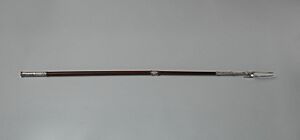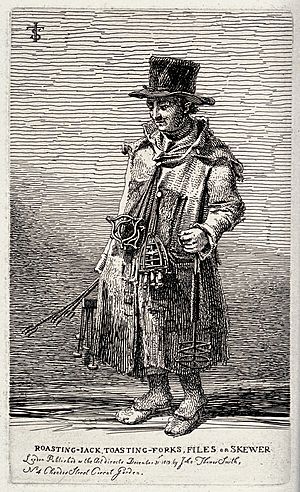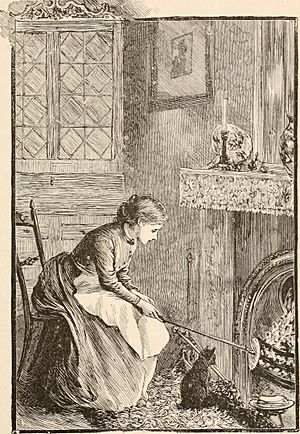Toasting fork facts for kids
A toasting fork is a tool with a long handle and prongs. People use it to hold food like bread, cheese, or apples. You hold the food over a fire or other heat source. This helps the food turn brown and get crispy, a process called "toasting." Toasting forks are also great for cooking marshmallows, hot dogs, or warming buns over a campfire.
Contents
What is a Toasting Fork?
Toasting forks were first made from metals like iron, brass, or silver. Later, steel was used. The handles were often made of wood or ivory. This kept the heat from the fire from reaching your hand. You simply poke the food with the prongs and hold it over the fire. You need to be careful to toast the food evenly so it doesn't burn.
Many toasting forks had a small ring on one end. This allowed them to be hung up when not in use. Some forks even had handles that could slide in and out. This made them easy for travelers to carry. It also let you hold the food closer to the fire without burning your fingers.
Most toasting forks were held by hand. But some were built into special stands called "trivets." These could swivel over the fire, like a desk lamp. Collectors sometimes call these "lazy toasters."
A Look Back in Time
Toasting forks have been around for a long time.
Toasting Forks in Britain
In England, people used toasting forks as far back as the mid-1500s. Only wealthy people usually owned them. In old plays by William Shakespeare, toasting forks were even compared to swords! A toasting fork from the 1600s is kept in the Shakespeare Birthplace Trust collection today.
In the 1700s, many toasting forks had three prongs that were not all at the same height. This helped hold the bread better. Toasting cheese became very popular. So, some forks were made with special parts to hold a slice of cheese as well as bread. Some forks from Scotland had fancy designs.
Many inventors tried to make better toasting forks starting in the late 1700s. James Watt, famous for the steam engine, made a toasting fork that could pull back. Sir Edward Thomason invented several sliding forks. One popular design had prongs that could fold into a handle shaped like a snake's head. Another of his inventions was a fork that could also brush the fireplace.
Toasting forks were very popular in the 1800s. They are often mentioned in books by Charles Dickens. In Oliver Twist, the character Fagin is first seen holding a toasting fork by a fire. In The Pickwick Papers, Mr. Stiggins checks his toast with a fork by the fireplace.
In 1854, Chef Alexis Soyer wrote a recipe for how to make toast properly. He explained how to use a toasting fork. Stores like Harrods sold many sizes of toasting forks in 1895. They continued to be used into the 1900s. This was true even when homes started using gas stoves instead of open fires.
Toasting Forks in North America
In 1620, the Pilgrims brought toasting forks with them when they came to America on the Mayflower. They had these forks for cooking, but they didn't have forks for eating at the table yet. Some early American colonists had fancy toasters that could hold many pieces of bread. But most people used simple iron toasting forks. These forks were important in American kitchens in the 1800s.
In 1868, a magazine called American Agriculturalist gave advice on making toast. It said to use old bread, not fresh. You should slice the bread thinly. Then, put it on a toasting fork and hold it near the fire to warm it. Finally, move it closer to the fire until it turns light brown or golden yellow. Then you could butter it.
In 1877, the same magazine showed how to make a homemade toasting fork. You could use a piece of tin, like from a sardine can. You would cut three triangles and bend them up to make prongs. Then, you would twist three wires together to make a handle.
Toasting Forks Today
Electric toasters started to appear in the early 1900s. But the first ones were not automatic. You still had to watch your toast. Toasting forks became less common in homes after automatic electric toasters came out in 1926. This was especially true as more homes got electricity in the 1930s. However, in the United Kingdom, people still used toasting forks if they had fireplaces or electric heaters. In the 1900s, toasting crumpets over an open fire with a fork was a popular winter treat in England.
Today, people often use toasting forks around campfires. They might make them from Y-shaped tree branches or wire coat hangers. You can also buy them as an accessory for wood-burning stoves. Sometimes, they are sold as a fun, old-fashioned item.
In 2022, a newspaper article joked about people using fancy extendable marshmallow forks for camping. They said it turned camping into "glamping" (glamorous camping). In the UK, many people still believe that the "perfect" way to make toast is with a toasting fork and a real fire, even if electric toasters are faster.
Scientists and Toasting Forks
In the 1800s, the scientist Michael Faraday used a toasting fork in his lectures. He once used it as part of an electrical machine he built with everyday objects.
In the 1900s, physicist G. I. Taylor experimented with a four-pronged toasting fork. He found that when air flowed through the prongs in a certain way, they made a much louder sound.
Where to See Them
The Victoria and Albert Museum has a collection of toasting forks. Most of these were collected by Louis Clarke, who loved old things.
Gallery










